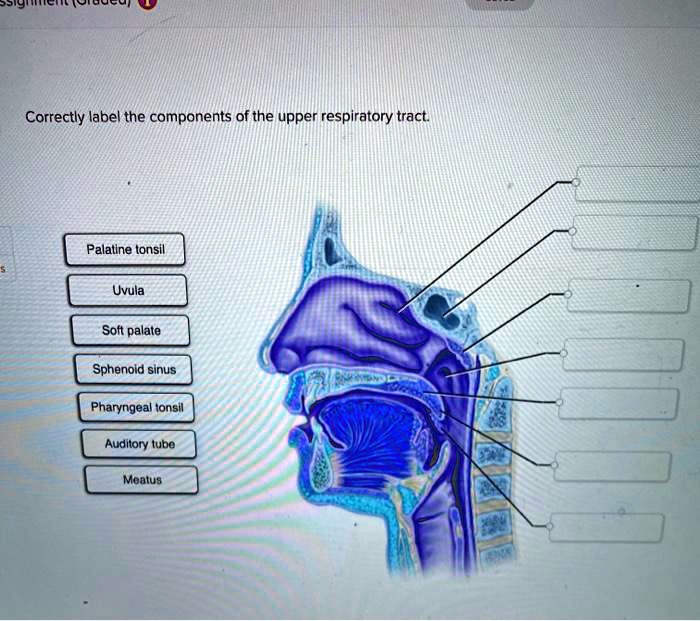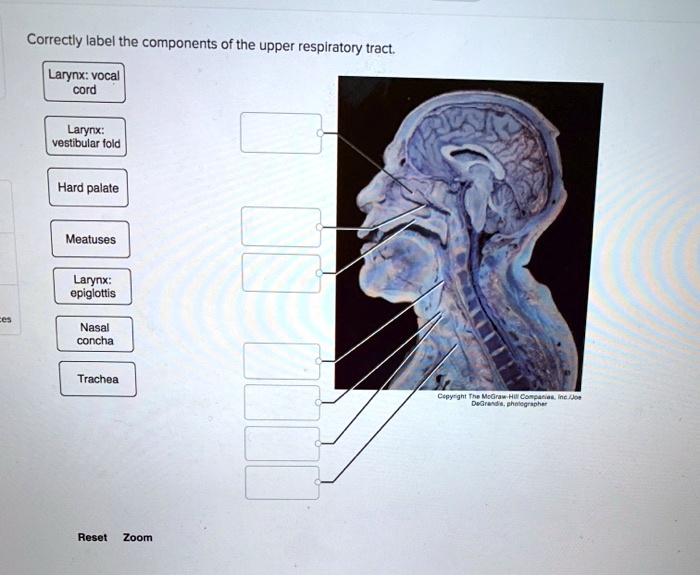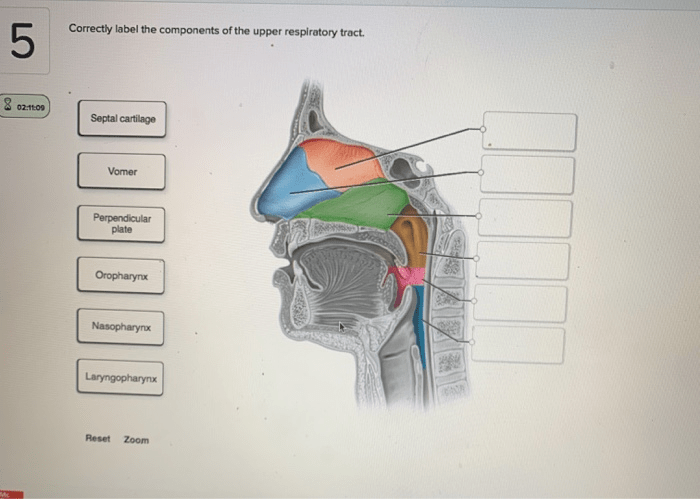Correctly label the components of the upper respiratory tract. – Correctly labeling the components of the upper respiratory tract is essential for a comprehensive understanding of human anatomy. This intricate system plays a crucial role in respiration, olfaction, and phonation. Delving into its anatomical structure, histological features, clinical significance, and surgical approaches provides a holistic perspective on this vital region.
Components of the Upper Respiratory Tract: Correctly Label The Components Of The Upper Respiratory Tract.

The upper respiratory tract is the portion of the respiratory system that extends from the nostrils to the larynx. It consists of the nasal cavity, pharynx, and larynx.
Nasal Cavity
The nasal cavity is a hollow space located behind the nose. It is lined with mucous membranes that help to warm and humidify the air we breathe. The nasal cavity also contains the olfactory receptors, which allow us to smell.
Pharynx
The pharynx is a muscular tube that connects the nasal cavity to the larynx. It is divided into three sections: the nasopharynx, oropharynx, and laryngopharynx. The nasopharynx is located behind the nose and contains the adenoids. The oropharynx is located behind the mouth and contains the tonsils.
The laryngopharynx is located behind the larynx and contains the epiglottis.
Larynx
The larynx is a cartilaginous structure that contains the vocal cords. It is responsible for producing sound. The larynx is also known as the voice box.
Histological Features of the Upper Respiratory Tract

Nasal Mucosa
The nasal mucosa is a thick, moist membrane that lines the nasal cavity. It is composed of a layer of ciliated epithelium, a layer of goblet cells, and a layer of connective tissue. The ciliated epithelium helps to move mucus and debris out of the nasal cavity.
The goblet cells produce mucus, which helps to keep the nasal cavity moist. The connective tissue provides support for the nasal mucosa.
Pharyngeal Mucosa
The pharyngeal mucosa is a thin, dry membrane that lines the pharynx. It is composed of a layer of stratified squamous epithelium and a layer of connective tissue. The stratified squamous epithelium helps to protect the pharynx from abrasion. The connective tissue provides support for the pharyngeal mucosa.
Laryngeal Mucosa
The laryngeal mucosa is a thin, moist membrane that lines the larynx. It is composed of a layer of ciliated epithelium, a layer of goblet cells, and a layer of connective tissue. The ciliated epithelium helps to move mucus and debris out of the larynx.
The goblet cells produce mucus, which helps to keep the larynx moist. The connective tissue provides support for the laryngeal mucosa.
Clinical Significance of the Upper Respiratory Tract

Nasal Cavity Diseases
The nasal cavity is commonly affected by a variety of diseases and disorders, including:
- Rhinitis: Inflammation of the nasal mucosa
- Sinusitis: Inflammation of the sinuses
- Nasal polyps: Benign growths that can block the nasal passages
- Nasal septum deviation: A condition in which the nasal septum is deviated to one side
Pharyngeal Infections
The pharynx is commonly affected by a variety of infections, including:
- Pharyngitis: Inflammation of the pharynx
- Tonsillitis: Inflammation of the tonsils
- Laryngitis: Inflammation of the larynx
Laryngeal Disorders
The larynx is commonly affected by a variety of disorders, including:
- Laryngeal papillomatosis: A condition in which warts grow on the vocal cords
- Laryngeal cancer: A type of cancer that occurs in the larynx
- Vocal cord paralysis: A condition in which the vocal cords are unable to move
Surgical Anatomy of the Upper Respiratory Tract

Nasal Cavity Surgery
The nasal cavity can be accessed through a variety of surgical approaches, including:
| Approach | Description |
|---|---|
| External rhinoplasty | An incision is made in the columella, the skin between the nostrils. |
| Endonasal rhinoplasty | An incision is made inside the nose. |
| Septoplasty | An incision is made in the nasal septum. |
| Turbinectomy | An incision is made in the turbinates, the bony structures that line the nasal cavity. |
Pharyngeal Surgery
The pharynx can be accessed through a variety of surgical approaches, including:
| Approach | Description |
|---|---|
| Transoral approach | An incision is made in the mouth. |
| Transnasal approach | An incision is made in the nose. |
| Transcervical approach | An incision is made in the neck. |
Laryngeal Surgery
The larynx can be accessed through a variety of surgical approaches, including:
| Approach | Description |
|---|---|
| Transoral approach | An incision is made in the mouth. |
| Transcervical approach | An incision is made in the neck. |
| Laryngectomy | The larynx is removed. |
User Queries
What are the main components of the upper respiratory tract?
The upper respiratory tract comprises the nasal cavity, pharynx, and larynx.
What is the function of the nasal mucosa?
The nasal mucosa filters, warms, and humidifies inhaled air, contributing to respiratory protection.
What are the common diseases associated with the nasal cavity?
Rhinitis, sinusitis, and nasal polyps are prevalent conditions affecting the nasal cavity.